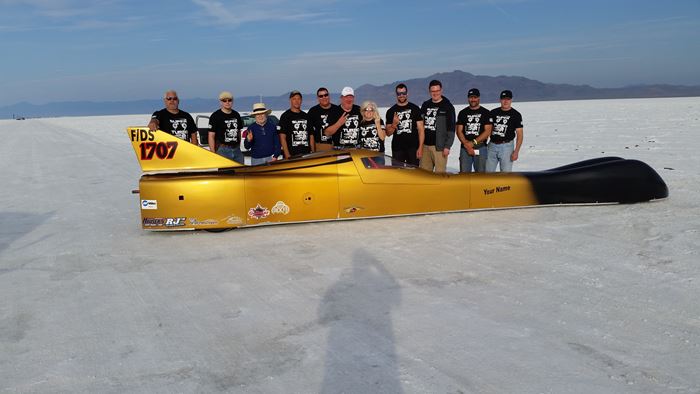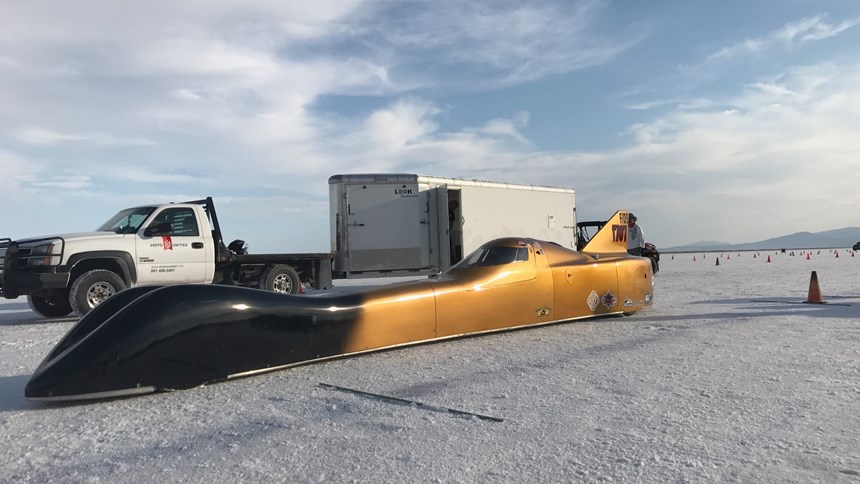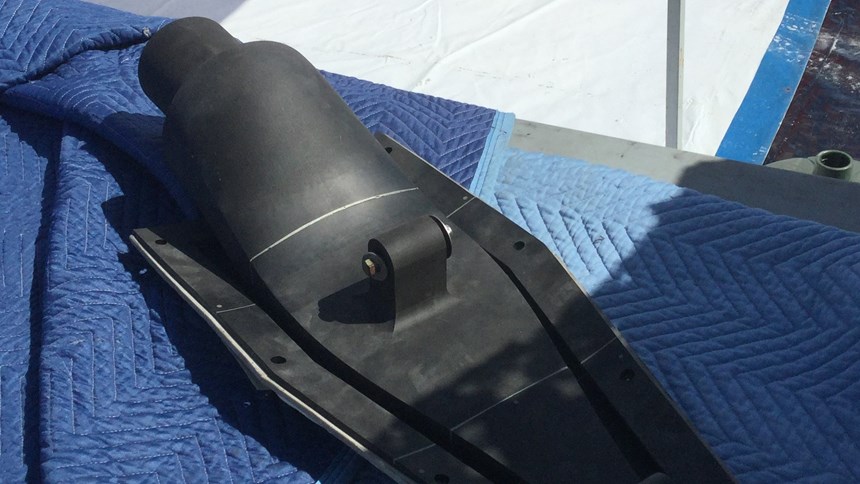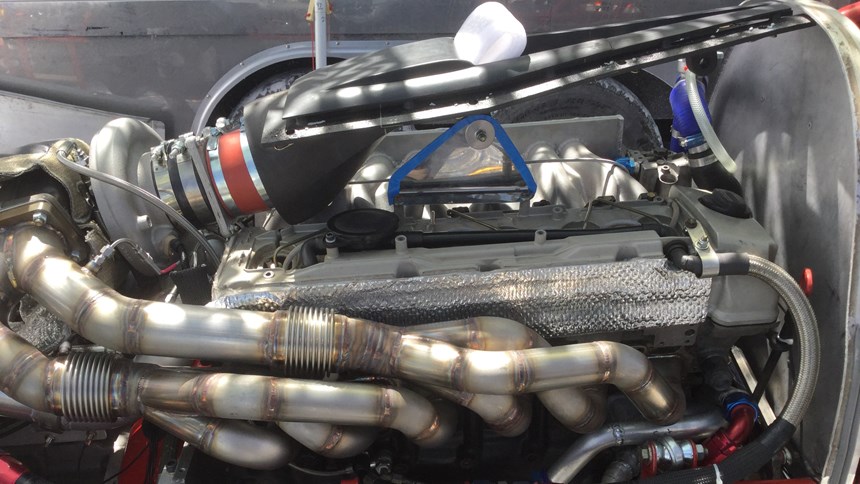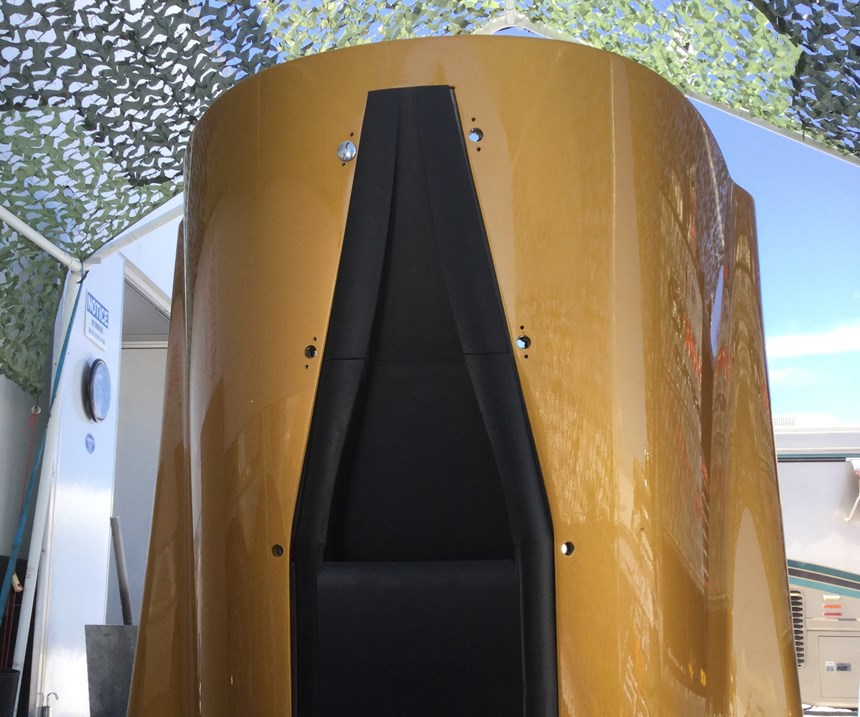3D-Printed Windform SP Part Helps Team Set New Speed Record
With no time left to make a NACA duct out of fiberglass using a mold and layup tooling, CRP USA 3D printed it from Windform SP to withstand the conditions of the Bonneville Salt Flats.
On the expanse of salt east of the town of Wendover, Utah, is a racing venue called the Bonneville Salt Flats. For more than 100 years, it has attracted racers and challenged them to test the limits of speed. The salt flats can be a harsh environment for the cars that race there, especially when the tracks get rough. To race at the Bonneville Salt Flats, cars need to be able to withstand the high-frequency vibrations, sun and intense heat that the races and environment generate.
Despite these challenges, racers don’t need giant budgets or thousands of horsepower to compete. Some speed records are still less than 100 mph, so with creativity and smart use of budget, many have a shot at the record books during Bonneville’s annual Speed Week.
A range of car types and engine classes race at the salt flats, including Streamliners. The only rules for these cars are that they must have non-production bodies and at least two wheels covered by the fairing. The rest of the car is up to the racer.
The Junkyard 300
Burton Brown of Victory Motorsports heads a small team from Dale, Wisconsin, that has worked to set speed records in its Streamliner. His crew is a combination of skilled craftsmen and weekend warriors that dedicate their time to a form of racing that requires a team approach.
For Speed Week 2017, the team had several goals. First, it wanted to break the long-standing record for its Streamliner’s car type and engine class, which had been set at 199.015 mph in 1979. The team also hoped to go over 250 mph, which would earn it a AA license that would give it a chance to attempt 300 mph.
“We named this venture ‘The Junkyard 300,’ as the engine we were using came directly out of the salvage yard in January without disassembly,” Brown says. The team made a few changes to the engine and obtained many other parts for the car cheaply. “We try to cut costs where we can, so we can use the money we save for the trip back and forth from the salt,” he adds. “That is part of the fun for me.”
Running Out of Time for a Key Component
A key component for Victory Motorsports’ attempt to meet its goals was a new NACAintake duct, a submerged, low-drag air inlet that’s common on aircraft and race cars.
The part is nearly 28 inches long with a complex design. It has an external raised ring around the perimeter of the duct, which is designed to pull in air, as well as an internal bump at the base of the inlet to the turbo charger that helps direct air flow and reduce turbulence.
The intake duct was intended to be made of fiberglass via a mold and layup tooling. However, less than a week before loading the car onto the trailer for the 1,600-mile, 32-hour drive, the team realized that the complex design was not going to be complete. The combination of high-frequency vibrations, intense sun and high temperatures the duct had to withstand narrowed the team’s manufacturing options.
As the team was running out of time, Stewart Davis from CRP USA called to check on the progress of the engine in another of the team’s cars. “I explained we were struggling with the duct and asked if Stewart and his team could help us with that challenge,” Brown says. “So, we talked more about the possibility of CRP making the scoop. Without hesitation, Stewart asked for the model.”
Because of the complex shape and tight timeframe, CRP USA 3D printed the part via selective laser sintering (SLS) on a modified 3D Systems machine . For the material, it chose Windform SP, a carbon fiber-reinforced composite polyamide. Windform SP’s mechanical features, thermal properties, stability in ultraviolet radiation, and resistance to high temperatures and vibration made it suitable for the harsh environment of the salt flats.
Because of its size and complex internal features, the part was built in three sections. CRP’s finishing team then polished it to give it the smoothness required for optimum flow.
CRP USA received the final model on July 26. When the intake duct was complete, CRP sent it to Victory Motorsports, where it arrived on August 1.
Complications Arise
Upon arrival, the fitment was confirmed in the engine bay. But a complication arose when the newly painted fairing arrived. “The fit to the engine was great but the curvature to the body from the scans must have been off a little, and this created some challenges getting it to fit to the body,” Brown says. With the clock ticking, the team loaded everything into the truck and headed for Utah.
Brown had invited Davis to watch the Streamliner race at the salt flats, and when he arrived on Friday morning, he reviewed the fitment issues with the team. “Attempting to force the part was not working,” Davis says. “Windform SP is a very tough material, so the decision was to fracture a section of the part to allow a little give, so it would match the curve of the fairing, and then reinforce it by riveting an aluminum backing plate.” The team worked Saturday and Sunday to modify and refit the duct with tools available onsite and prepare for its first runs.
Putting Power to the Salt
On Sunday, the Streamliner passed tech, and the team prepared for a Monday morning run. Conditions were good Sunday, but the track was starting to get rough in some areas. “The track was a lot rougher than I had ever experienced at Bonneville,” says Brown. Despite the conditions, Victory Motorsport’s Streamliner qualified for the record with an exit speed of 234 mph.
To gain the record, the team still had to complete a second run, with the average speed of the two used to determine the new record. The car was placed in impound, where the team had four hours to inspect its safety for the follow-up run. The second run was scheduled for Tuesday morning.
During the second run, Brown says the engine was making power, but the rough surface made it difficult to get the power to the salt. “I was pretty sure we got the record but needed verification from the crew,” he says. When the radio announcer called a new class record, the team celebrated.
“The Windform SP part performed extremely well, and held up to all of the abuse, even being heavily modified while on the salt flats, with limited tools and time. It gave us no issues withstanding the speed and the rough track and vibrations,” he adds. “It is a very light, strong material that can also take the extreme heat generated in the very tightly-fitted body. A few years ago, I wouldn’t have dreamed of having something like this on the Streamliner.”
“It was great to be a part of the team’s record-setting run, and we congratulate Burton and his team on the record,” Davis says. “We are fortunate to work with teams that are dedicated to their sport, and the Victory Motorsports Team is a great example of the hard work and determination it takes to be successful.”
“With the traction issues and exit speed of 234 mph, we know there is a lot more in this car and setup,” Brown says. He and the team feel that 300 mph is a possibility for the Streamliner.
Related Content
Understanding PEKK and PEEK for 3D Printing: The Cool Parts Show Bonus
Both materials offer properties desirable for medical implants, among other applications. In this bonus episode, hear more from Oxford Performance Materials and Curiteva about how these companies are applying PEKK and PEEK, respectively.
Read MoreActivArmor Casts and Splints Are Shifting to Point-of-Care 3D Printing
ActivArmor offers individualized, 3D printed casts and splints for various diagnoses. The company is in the process of shifting to point-of-care printing and aims to promote positive healing outcomes and improved hygienics with customized support devices.
Read MoreFDA-Approved Spine Implant Made with PEEK: The Cool Parts Show #63
Curiteva now manufactures these cervical spine implants using an unusual 3D printing method: fused strand deposition. Learn how the process works and why it’s a good pairing with PEEK in this episode of The Cool Parts Show.
Read MoreConcept Sneaker Boasts One-Piece 3D Printed TPU Construction
The Reebok x Botter Concept Sneaker Engineered by HP premiered at Paris Fashion Week, hinting at manufacturing possibilities for the future of footwear.
Read MoreRead Next
3D Printed Polymer EOAT Increases Safety of Cobots
Contract manufacturer Anubis 3D applies polymer 3D printing processes to manufacture cobot tooling that is lightweight, smooth and safer for human interaction.
Read MoreAlquist 3D Looks Toward a Carbon-Sequestering Future with 3D Printed Infrastructure
The Colorado startup aims to reduce the carbon footprint of new buildings, homes and city infrastructure with robotic 3D printing and a specialized geopolymer material.
Read MoreProfilometry-Based Indentation Plastometry (PIP) as an Alternative to Standard Tensile Testing
UK-based Plastometrex offers a benchtop testing device utilizing PIP to quickly and easily analyze the yield strength, tensile strength and uniform elongation of samples and even printed parts. The solution is particularly useful for additive manufacturing.
Read More

